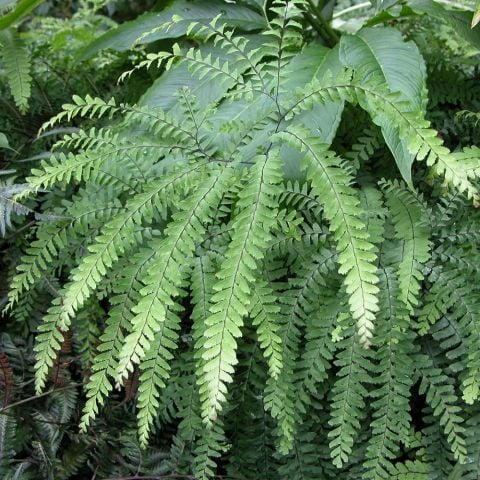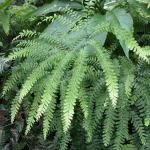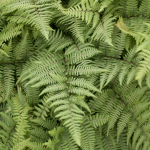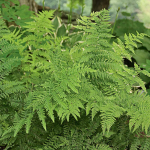Ferns: Planting & Care
Indispensable for shady areas in the yard, Ferns are delicate-looking plants that make the hottest summer day seem cooler. Great variety exists in form and size, giving the creative gardener many planting options. Most Ferns are slow growing and can take several years to reach their mature size, which varies greatly between varieties.
Light/Watering: All Ferns thrive in light to heavy shade. A few, such as Lady Ferns (Athyrium filix-femina) will grow in full sun in the North, provided the planting site is damp. Water Ferns regularly if rain is not sufficient, and do not let the soil get completely dry. A 2″ thick mulch of composted leaves or pine needles will help keep roots cool and damp.
Fertilizer/Soil and pH: Ferns prefer soils high in organic matter that are well-drained but do not dry out. Most will tolerate poor soils and a pH of 4 to 7; Maidenhair Fern (Adiantum) prefers a more alkaline soil between pH 7 to 8, but will grow at a lower pH. Apply fertilizer in spring, just after new growth has begun. Ferns are very sensitive to fertilizers; use a slow-release fertilizer when new growth appears in early spring. For initial planting of bareroot plants, lay the mat formers (Adiantum, Athyrium, Dennstaedtia, and Dryopteris) with buds and old fronds facing up in a shallow hole and cover with an inch of soil. Plant bareroot crown-formers (Matteuccia, Osmunda, Phyllitis, and Polystichum) with the growing tips just barely showing through the soil surface. Ferns are notoriously slow to send up new growth after planting, but good things come to those who wait.
Pests/Diseases: None serious enough to worry about, other than the occasional slug attack. Fight back with bait or diatomaceous earth sprinkled around the base of the fronds.
Tips for Growing Garden Ferns
Companions: Ferns are lovely with other shade-lovers such as Alchemilla, Brunnera (False Forget-me-not), Dicentra (Bleeding Heart), Hosta, Mertensia (Virginia Bluebells), Phlox divaricata, Pulmonaria (Lungwort), Tiarella (Foam Flower), and Viola. They add fabulous texture to woodlands and landscape plantings. Ferns are deer-resistant, so they make an excellent choice for a woodland garden where deer are a problem.
Dividing/Transplanting: When Fern fronds appear to be smaller, or the clump has a bare center, it is time to divide. Some Ferns form crowns while others grow as mats of fibrous roots. Dig up the whole clump and take 6″-square pieces from the most vigorous growth. Replant at the original depth and water well.
Calendar of Care for Garden Ferns
Early Spring: Divide or transplant as soon as new growth appears, and water well if it is unseasonably dry, as plants prefer an evenly moist soil. Fertilize gently with a slow-release fertilizer or use an organic mulch. Recently planted Ferns may be slow to appear, but be patient.
Mid-Spring: Water consistently if rainfall is not sufficient to keep soil moist. Apply a 2″ thick mulch of composted leaves or pine needles.
Late Spring: Watch for slug or snail damage and treat as necessary.
Summer: Continue regular watering as needed to maintain soil moisture.
Fall: Cut foliage back to soil level when it dies back after a heavy frost. When the ground freezes, mulch to protect plants from heaving out of the soil in winter.
Growing Ferns as Houseplants
Tropical Ferns are splendid garden plants where nighttime temperatures are above 60°F, and they make excellent houseplants as well. They require only filtered light and moderate humidity to grow well indoors.
Light: Tropical Ferns grow best in filtered or indirect light. An east- or north-facing window is ideal.
Humidity: Most houseplants are native to tropical or subtropical regions of the world, where relative humidity is typically very high. They suffer in the dry air produced by furnaces and woodstoves. The best way to increase the humidity around your plants is to run a humidifier nearby. You can also set plants in trays filled with pebbles or gravel. Add water to a level just below the tops of the pebbles (if the potting mix in the pots comes in contact with the water, the mix will draw water into the pot, which will cause the mix to become saturated, eventually leading to rot). Refill trays frequently to replace water lost through evaporation.
Fertilizer: During the growing season (generally April into September) fertilize potted plants once a month using a houseplant formula mixed at 1/2 strength. Withhold fertilizer in fall and winter, when most plants rest.
Shop All Ferns
Garden Ferns We Offer:
 Adiantum pedatum - Maidenhair Fern
Adiantum pedatum - Maidenhair Fern
Houseplant Ferns We Offer:





